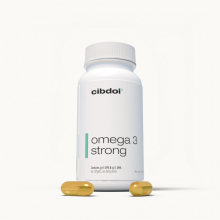Do Walnuts Have Omega-3 Fatty Acids?
Published:
Walnuts are a nutritious tree nut that provide protein, fiber, vitamins, minerals and plant-based fats. But when it comes to omega-3s, are walnuts a good source of these important fatty acids?
Contents:
The answer is yes, walnuts are one of the best plant-based sources of the omega-3 fat ALA (alpha-linolenic acid). They provide significant amounts in each serving.
However, walnuts do not contain the omega-3s EPA and DHA found in fatty fish. Still, incorporating walnuts into your diet can help you meet daily omega-3 recommendations.
Below is an in-depth look at the omega-3 content of walnuts, how they benefit your health, and how to get enough of these essential fats.

Omega-3s in Walnuts
Walnuts are rich in the plant-based omega-3 fat ALA.
One ounce (28 grams) of walnuts contains (1):
- Calories: 185
- Total fat: 18 grams
- Protein: 4 grams
- Fiber: 2 grams
- ALA omega-3s: 2,500 mg
As you can see, walnuts provide 2,500 mg of ALA in each one ounce serving. This is one of the highest amounts among plant sources of omega-3 fats.
By comparison, popular omega-3 foods like salmon, chia seeds and flaxseeds provide around 1,000–3,000 mg per serving as well (2, 3, 4).
So walnuts can be considered an excellent plant-based source of the essential omega-3 fat ALA.
However, it’s important to note that walnuts do not provide any EPA or DHA, the omega-3 fatty acids found in fatty fish that have the most health benefits.
Still, getting ALA from walnuts and other plant foods is important. Keep reading to understand why.
Why Omega-3s Matter
Omega-3 fatty acids provide a wide range of benefits for your health, which is why it’s important to get enough from your diet.
Here is an overview of the many benefits linked to omega-3s:
Heart Health
Omega-3s support a healthy heart in a number of ways:
- Lower triglycerides — high levels raise heart disease risk (5).
- Reduce blood pressure — omega-3s act as a mild blood thinner (6).
- Prevent plaque buildup — decreases fatty deposits inside arteries (7).
- Reduce irregular heartbeats — linked to sudden cardiac death (8).
- Raise “good” HDL cholesterol (9).
Brain Health
Omega-3s also play important roles in brain function and development:
- Sharpen memory and thinking — linked to better cognition in adults (10, 11).
- Help fight depression — associated with reduced rates of depression (12).
- Aid fetal brain development — DHA is vital for babies’ brain growth (13).
- Support healthy aging — helps prevent cognitive decline (14).
Eye Health
Omega-3s help protect your eyes as you age:
- Reduce macular degeneration — leading cause of blindness (15).
- Treat dry eye disease — improve tear production and quality (16).
- Benefit babies’ vision — DHA intake in pregnancy reduces vision problems (17).
Anti-Inflammatory Effects
The omega-3s EPA and DHA have powerful anti-inflammatory properties that can:
- Lower inflammation — reducing inflammatory markers like C-reactive protein (18).
- Relieve joint pain — decrease swelling and stiffness in rheumatoid arthritis (19).
- Benefit autoimmune conditions — shown to help lupus, eczema, IBD (20).
As you can see, omega-3 fatty acids provide major benefits for nearly every part of your body. But how much do you need to reap these benefits?
Omega-3 Recommendations
Major health organizations recommend getting at least 250–500 mg of combined EPA and DHA omega-3s per day for optimal health (21, 22).
Higher daily intakes up to 1,000–2,000 mg are sometimes suggested for people with heart disease, high triglycerides or metabolic syndrome risk factors (23).
Pregnant and breastfeeding women need at least 300–900 mg of DHA daily for proper development of babies’ brains and eyes. Children should take omega-3s according to their age and calorie needs (24).
Those following plant-based diets may require more omega-3s than average due to low intakes from foods (25).
When reading labels, look for the combined totals of EPA + DHA, rather than just omega-3 or fish oil content.
While walnuts don’t provide EPA or DHA, their high ALA content can help you reach daily omega-3 goals when combined with fatty fish and other sources.
Top 10 Omega-3 Food Sources
To meet your omega-3 needs, here are the top 10 dietary sources:
1. Oily Fish
Salmon, sardines, mackerel and herring are high in anti-inflammatory EPA and DHA. Just 3 ounces (85 grams) of salmon provides over 1,000 mg (26).
2. Fish Oil Supplements
Fish oil capsules provide concentrated doses of EPA and DHA omega-3s. Many provide 500–1,000 mg per serving.
3. Walnuts
Walnuts offer 2,500 mg plant-based ALA per ounce (28 grams) (1).
4. Flaxseeds
Flaxseeds contain 2,300 mg of ALA per ounce (28 grams) (27).
5. Chia Seeds
Chia seeds deliver 5 grams of ALA omega-3s in just 1 ounce (28 grams) (3).
6. Soybeans
Edamame, tofu and tempeh contain ALA. A half cup (170 grams) of soybeans has nearly 1,000 mg (28).
7. Hemp Seeds
Hemp seeds provide 1,200 mg of plant-based ALA per ounce (28 grams) (29).
8. Brussels Sprouts
Brussels sprouts offer 135 mg of ALA per half cup (44 grams) (30).
9. Algal Oil
Algal oils supply vegan EPA and DHA from marine algae.
10. Beans
Kidney beans, chickpeas and other beans contain ALA. One cup (172 grams) of kidney beans has 430 mg ALA (31).
Prioritizing these top sources ensures you get sufficient anti-inflammatory omega-3s.
Health Benefits of Walnuts
Walnuts not only provide omega-3 ALA fats, but many other nutrients and health-promoting compounds:
High in Antioxidants
Walnuts contain polyphenols and vitamin E that combat inflammation and oxidative stress in your body (32).
May Improve Heart Health
Eating walnuts is linked to reduced cholesterol levels, blood pressure and artery plaque buildup (33, 34).
May Benefit Weight Control
Despite being high in fat and calories, some studies link walnut intake to slightly lower body weight (35).
Supports Brain Function
Test tube and animal studies indicate walnuts may benefit brain health due to their antioxidant content (36).
Contains Other Key Nutrients
Walnuts provide manganese, copper, phosphorus and B vitamins in addition to healthy fats, protein and fiber.
Healthy Ways to Eat More Walnuts
Here are easy ways to add more walnuts to your diet:
- Sprinkle chopped walnuts onto oatmeal or yogurt.
- Mix into homemade granola or trail mixes.
- Add to salads for crunch and healthy fats.
- Blend into smoothies.
- Bake into muffins, breads or cookies.
- Coat fish or poultry with chopped walnuts before baking.
- Use walnut oil in dressings and dips.
- Make homemade walnut butter.
- Enjoy a small handful as an on-the-go snack.
Pair walnuts with omega-3-rich foods like fatty fish at meals for maximum anti-inflammatory benefits.
Getting Omega-3s Without Walnuts
Here are other simple ways to meet your daily omega-3 needs if you don’t eat walnuts:
- Eat fatty fish like salmon 2–3 times per week.
- Take fish, krill or algae oil supplements.
- Add chia and hemp seeds to smoothies, oatmeal and yogurt.
- Snack on other omega-3-rich nuts like almonds, pecans and hazelnuts.
- Use omega-3 cooking oils like canola, soybean and olive oil.
- Look for omega-3-enriched eggs, milk and other products.
- Enjoy omega-3-rich beans like kidney, pinto and black beans.
With some planning, you can get sufficient omega-3s through a variety of foods even if you don’t eat walnuts.
Key Takeaways on Walnuts and Omega-3s
Here are some key points to understand about walnuts and their omega-3 content:
- Walnuts provide 2,500 mg of the plant-based omega-3 ALA per 1-ounce serving.
- They do not contain any of the omega-3s EPA or DHA found in fish and algae.
- ALA omega-3s are still important for health, especially for those following plant-based diets.
- Pair walnuts with fatty fish or algae oil to get a combination of EPA/DHA and ALA.
- Stick to recommended portions of walnuts, as they are high in calories.
While walnuts are one of the best plant sources of omega-3s, they should be enjoyed alongside oily fish or supplements to obtain anti-inflammatory EPA and DHA as well.
Frequently Asked Questions
Here are answers to some common questions about walnuts and their omega-3 content:
Are black walnuts higher in omega-3s than English walnuts?
Most research shows minimal differences between black walnut and English walnut nutrition profiles. Expect both types to provide around 2,500 mg ALA per ounce.
Do omega-3 walnuts provide EPA and DHA?
Walnuts naturally only contain ALA. Some brands inject EPA/DHA oils into walnuts. If they provide at least 250–500 mg per serving, they can help you meet daily omega-3 targets.
Is walnut oil a good source of omega-3s?
Yes, walnut oil provides a concentrated source of ALA. Just 1 teaspoon (4 grams) offers over 2,000 mg ALA. Drizzle on salads and cooked veggies.
Are roasted walnuts healthier than raw walnuts?
Light roasting may enhance walnuts' antioxidant capacity. However, over-roasting can damage their omega-3s. Enjoy walnuts raw or lightly roasted in moderation.
Do sprouted walnuts have more omega-3s?
Sprouting walnuts may increase their antioxidant activity, but it does not increase their ALA omega-3 content.
Can walnuts improve heart health?
Yes, studies show walnuts may reduce heart disease risk factors like high cholesterol and blood pressure, likely due to their combination of omega-3s, fiber, antioxidants, and other plant compounds.
Walnuts offer a hearty dose of plant-based omega-3s. For optimal health, aim to also include EPA and DHA sources in your diet via fatty fish, fortified foods, or supplements.
The Bottom Line
Walnuts are one of the richest plant-based sources of the omega-3 fat ALA, providing 2,500 mg per one ounce serving. However, they do not contain EPA or DHA. For optimal omega-3 intake and anti-inflammatory benefits, enjoy walnuts along with fatty fish, omega-3 fortified foods or algal oil. Walnuts are a tasty way to help meet your daily ALA needs.










